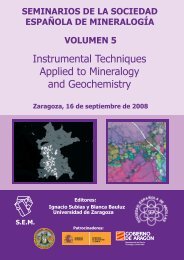2011 Jornada CientÃfica de la Sociedad Española de Arcillas 14 de ...
2011 Jornada CientÃfica de la Sociedad Española de Arcillas 14 de ...
2011 Jornada CientÃfica de la Sociedad Española de Arcillas 14 de ...
Create successful ePaper yourself
Turn your PDF publications into a flip-book with our unique Google optimized e-Paper software.
<strong>Jornada</strong> Científica <strong>de</strong> <strong>la</strong> <strong>Sociedad</strong> Españo<strong>la</strong> <strong>de</strong> Arcil<strong>la</strong>s. <strong>14</strong> <strong>de</strong> Noviembre <strong>de</strong> <strong>2011</strong><br />
BIONANOCOMPOSITES BASED ON CELLULOSE DERIVATIVES AND<br />
SMECTITES<br />
Y. Koriche* , ** P. Aranda*, M. Dar<strong>de</strong>r*, S. Semsari**, E. Ruiz-Hitzky*<br />
* Instituto <strong>de</strong> Ciencia <strong>de</strong> Materiales <strong>de</strong> Madrid, CSIC, Cantob<strong>la</strong>nco, 28049<br />
Madrid, Spain<br />
** Laboratory of Chemical Engineering, University of Blida, 09000, Blida, Algeria<br />
Bionanocomposites represent an emerging group of advanced materials<br />
resulting from the assembling of different c<strong>la</strong>y minerals and biopolymers [1].<br />
Applications of this type of materials range from their use as green p<strong>la</strong>stics, in<br />
regenerative medicine and as new substrates to immobilize living entities,<br />
sorbents for pollutant removal to the <strong>de</strong>velopment of novel active phases of ionsensors<br />
of interest in environmental applications [2]. Natural or synthetic c<strong>la</strong>y<br />
minerals (<strong>la</strong>yered silicates such as montmorillonite or fibrous minerals such as<br />
sepiolite and palygorskite) are additives usually incorporated into the<br />
biopolymer matrix. Depending on the geometry and the nature of the nanofiller,<br />
new and improved properties (gas barrier, mechanical stiffness, transparency,<br />
thermal stability...) can be obtained.<br />
In this context, the present work introduces a study on the <strong>de</strong>velopment and<br />
characteristics of bionanocomposites based on cellulose <strong>de</strong>rivatives,<br />
hydroxypropylmethylcellulose (HPMC) and cellulose acetate (CA), assembled<br />
to two types of smectites, commercial Cloisite®Na and a purified bentonite from<br />
<strong>de</strong>posits in Maghnia, in the West of Algeria. The chemical composition of this<br />
bentonite is 69.4% SiO 2 , <strong>14</strong>.4% Al 2 O 3 , 1.2% MgO, 0.3% CaO, 0.5% Na 2 O,<br />
0.8% K 2 O, 0.2% TiO 2 and 0.05% of As, and its CEC is 80 meq/100 g [3]. One of<br />
the aims of this work is to valorize this natural resource as a potential<br />
component of advanced materials. In a first stage, HPMC was cationized by<br />
treatment with glycidyltrimethy<strong>la</strong>mmonium chlori<strong>de</strong> and there after used to<br />
produce its ion-exchange with Cloisite®Na + . Alternatively, CA was mixed with<br />
the bentonite in acetone to produce the bionanocomposite CA/bentonite. The<br />
resulting materials were characterized by using various techniques (FTIR, XRD,<br />
CHN analysis and SEM). XRD characterization of the resulting<br />
bionanocomposites confirms the interca<strong>la</strong>tion of the cationized HPMC between<br />
the <strong>la</strong>yers of Cloisite, as well as the exfoliation of bentonite in the CA matrix.<br />
The affinity of these bionanocomposites towards different heavy metal ions has<br />
61













